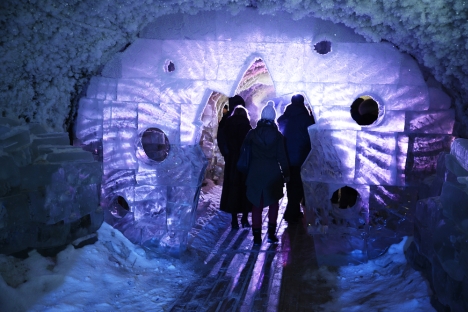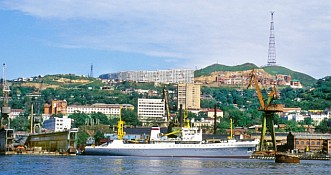Winter festivities take place in Russia's largest region

The Republic of Yakutia is the largest region in Russia and one of the least populous. In December, the republic holds a festival called Winter Begins in Yakutia. Source: Ivan Dementievskiy
Temperatures in Yakutia during the second weekend of December are a good 22 degrees below zero (Fahrenheit) — that is to say, temperatures are warm. Ordinarily, at this time of year, temperatures drop to 58 below zero. One can get used to anything.
Besides, thermal underwear, a hat, down parka and gloves will not allow you to perish on the frozen streets. Still, dressing for any venture outside is like dressing for a walk in open space. The cold burns physically wound your face. If you disregard ski pants, the cold, like a living creature, will cling to your legs; your jeans will freeze to your knees.
View Larger Map |
Meanwhile, local residents are ready to hang out with each
other in the freezing cold for hours. Street festivals are a common occurrence,
to say nothing of the fact that Yakuts love to spend their leisure time in the
open air — hunting, fishing, engaged in street works. All in all, it is a
matter of habit.
The Republic of Yakutia is the largest region in Russia (the size of India, or
five times the size of France) and one of the least populous (less than one
million inhabitants). In December, the republic holds a festival called Winter
Begins in Yakutia. The festival’s two main events are meetings with “Ded Moroz”
(“Grandfather Frost,” the Russian Santa Claus) and Chys Khaan (Yakutia’s
folktale hero responsible for the cold), and the “Stroganina” Festival.
It all looks rather fantastical. Chys Khaan, Yakutsk’s Grandfather Frost, was invented long ago by adapting local legends about the Winter Bull — a horned symbol of the ruthless elements. The result was a kind but scary and bearded old man who looks like the “sensei”in Quentin Tarantino’s “Kill Bill,” only in a hat with enormous horns.
Chys Khaan lives in a cave dug into the permafrost, where it is always 19 degrees in both winter and summer. Inside, there are permanent ices sculptures, including copies of the Venus de Milo, Picasso’s “Guernica,” and works by the ingenious Buryat artist Dasha Namdakov.
There is also an ice bar. The ice bar is an attraction that was conceived of here in Yakutia, although it does exist in several other places (rumor has it, in London and in Moscow). But here, it is right “in situ.”
Vodka and champagne are poured into shot glasses and glass flasks carved out of ice. To go with the iced drinks there is “stroganina”: raw fish that has been frozen right after being pulled out from under the ice and then cut into paper-thin slices with a sharp knife. These frozen slices are then dipped in salt and pepper — and, honestly, mankind is not likely to ever come up with a better accompaniment to vodka.
Yakuts eat almost no pork and are not overly fond of chicken, but they love venison, cow and horse meat. The flesh of colts is a staple food amongst these Northerners descended from Turkis. The latter wandered far north from either Mongolian nomads or the Golden Horde or from Tibet; even the Yakuts themselves do not know. Horse meat is truly delicious, although a little shameful — especially if one rode the horse before eating it.
The Stroganina Festival kicks off with a preliminary contest among teams who present towers and other constructions made out of stroganina to a panel of judges. This year, the most beautiful composition was of a mammoth — an unofficial symbol of the region.
Then there comes the main competition: teams of two (a man and a woman) must quickly cut frozen fish and create a tower on a dish. The man cuts, the woman creates. The result is judged for time taken and for beauty. The expert panel is made up of respected fisherman, eaters and city officials.
Meanwhile, one may buy fish, knives, fabulous dresses, hats and gloves made out of fish skin, and caps made out of horse hair. One may taste stroganina and other local foods. Between competitions, local dance groups perform: boys and girls illustrate various pastimes (catching fish, hunting bears, sorcery and courtship) with their dances. It is often hard to distinguish one pastime from another, as in life.
Later, pretty Yakut girls appear modeling locally made fur coats. Everyone wears traditional costumes. Beautiful woman are draped in silver. On festival days, Yakut women decorate themselves with all manner of adornments, which, in sum, may weigh up to 7.5 pounds.
In
everyday life, incidentally, there is at least one element of traditional dress
which Yakut men and women always wear: high fur boots made out of deerskin and
sometimes decorated with beads. They are expensive and very, very warm.
The desire of the local authorities to turn the Republic of Yakutia into a
tourist destination has met with different reactions: the image of nomads in
deerskins, dances and stroganina, guttural singing and shaggy horses is all
very well, of course; but in Yakutia there are also research institutes
(including the Institute of Permafrost, Russia’s northernmost university),
complex production lines, oil, gas, diamonds, gold and uranium.
In the capital city of Yakutsk, high-rise buildings are being built on the permafrost — in place of a foundation, posts are hammered in. Yakutsk boasts one of Russia’s best environments offering support to the disabled: even low-rise buildings have elevators for wheelchairs, and almost all public buildings are equipped with ramps.
Indeed, Yakutsk is an absolutely civilized city. Meanwhile, the
authorities are presenting it as though it were a remote village inhabited by
nomadic hunters and gatherers.
The logic of the local authorities is entirely transparent. Few people like
industrial tourism, and even those few enthusiasts would never be allowed to
see a uranium mine or a diamond factory. Many people do, however, like exotica,
national traditions, shaman spirituality and stroganina with vodka. They are
the ones who will come to Yakutia as tourists. In any case, that is what the
government of this marvelous republic is hoping.
All rights reserved by Rossiyskaya Gazeta.
Subscribe
to our newsletter!
Get the week's best stories straight to your inbox

